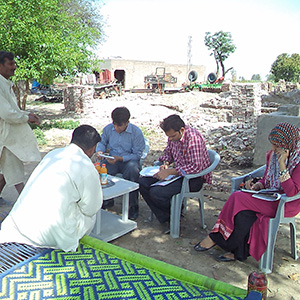Climate change risk perception and adaptation to climate smart agriculture are required to increase wheat production for food security

Accepted: 30 November 2022
HTML: 16
All claims expressed in this article are solely those of the authors and do not necessarily represent those of their affiliated organizations, or those of the publisher, the editors and the reviewers. Any product that may be evaluated in this article or claim that may be made by its manufacturer is not guaranteed or endorsed by the publisher.
Climate change poses a serious risk to wheat farmers in many regions of the world. The present study was conducted in the Sialkot District, Punjab, Pakistan, to investigate climate change trends during the past thirty years and to determine farmers’ knowledge and perceptions about climate change. The study also addresses the impacts of climate change on wheat production, current adaptation strategies, and limitations in adaptations to climate-smart agriculture (CSA) through a questionnaire-based survey. The historical weather data from the past thirty years indicated an increase in the mean annual minimum and maximum temperature and a decrease in annual total precipitation. Wheat productivity during the past thirty years showed an increasing trend but it was inconsistent. The respondents’ perception of climate change indicated that the literate farmers and those with broad farming experience were more knowledgeable about the climatic effects on wheat production. However, the survey results showed that the age of the farmers did not affect their perceptions. The current management practices are primarily based on prior experiences (70%) and traditional practices (30%). The standard management practices to increase farm productivity include an increase in fertilizer use (70%), a decrease in manure use (24%), and intercropping or switching to other crop cultivations (60%). The farmers stated that their reasons for limited adaptation to climate smart farm practices (CSFP) were due to their lack of knowledge and skills (86%), lack of modern technologies (74%), economic constraints (78%), politics (86%), and social influences (74%). Based on the survey results, the study suggests that addressing these gaps can increase farm-level wheat productivity to increase resilience. This can be achieved by introducing stateof- the-art farming practices through farmer training and by providing institutional services with a focus on climate-specific farm consultation services, leading to climate-smart agricultural practices for improved food security.
Highlights
- Literate farmers are more aware of climate change as compared to illiterate farmers.
- The farmers emphasized the increase in both the summer and winter temperature.
- Rainfall is identified as a major climate threat in the study area.
- The farmers identified that the highest impact of climate change occurred during the harvest phase of wheat.
- The farmers stated that the limited adoption of climate smart agricultural practices is due to lack of knowledge and technological, economic, and other gaps.
How to Cite

This work is licensed under a Creative Commons Attribution-NonCommercial 4.0 International License.
PAGEPress has chosen to apply the Creative Commons Attribution NonCommercial 4.0 International License (CC BY-NC 4.0) to all manuscripts to be published.

 https://doi.org/10.4081/ija.2022.2129
https://doi.org/10.4081/ija.2022.2129



